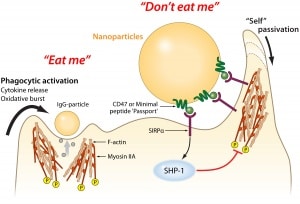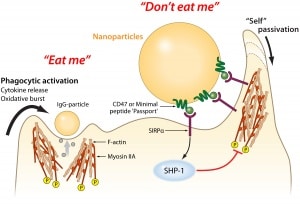
Research into using nanotechnology for improved drug delivery continues to advance as current nanoparticle technology is combined with increasingly more sophisticated biotechnology. One major problem with using nanoparticles for targeted drug delivery is that the patient’s immune system often clears the particle before they can be effective. A new approach uses a peptide derived from an important immune system molecule to fool the immune system. A commentary accompanying the publication (abstract) of the research in Science describes how short peptides from a human protein called CD47, which tells important immune system cells that cells or particles bearing the protein are human, not foreign, were used as a “passport” to get nanoparticles past the immune system. Additional details are supplied in a University of Pennsylvania news release “Penn Researchers Develop Protein ‘Passport’ That Helps Nanoparticles Get Past Immune System“:
… The research was conducted by professor Dennis Discher, graduate students Pia Rodriguez, Takamasa Harada, David Christian and Richard K. Tsai and postdoctoral fellow Diego Pantano … “From your body’s perspective,” Rodriguez said, “an arrowhead a thousand years ago and a pacemaker today are treated the same — as a foreign invader.
“We’d really like things like pacemakers, sutures and drug-delivery vehicles to not cause an inflammatory response from the innate immune system.”
The innate immune system attacks foreign bodies in a general way. Unlike the learned response of the adaptive immune system, which includes the targeted antibodies that are formed after a vaccination, the innate immune system tries to destroy everything it doesn’t recognize as being part of the body.
This response has many cellular components, including macrophages — literally “big eaters” — that find, engulf and destroy invaders. Proteins in blood serum work in tandem with macrophages; they adhere to objects in the blood stream and draw macrophages’ attention. If the macrophage determines these proteins are stuck to a foreign invader, they will eat it or signal other macrophages to form a barrier around it.
Drug-delivery nanoparticles naturally trigger this response, so researchers’ earlier attempts to circumvent it involved coating the particles with polymer “brushes.” These brushes stick out from the nanoparticle and attempt to physically block various blood serum proteins from sticking to its surface.
However, these brushes only slow down the macrophage-signaling proteins, so Discher and colleagues tried a different approach: Convincing the macrophages that the nanoparticles were part of the body and shouldn’t be cleared.
In 2008, Discher’s group showed that the human protein CD47, found on almost all mammalian cell membranes, binds to a macrophage receptor known as SIRPa in humans. Like a patrolling border guard inspecting a passport, if a macrophage’s SIRPa binds to a cell’s CD47, it tells the macrophage that the cell isn’t an invader and should be allowed to proceed on.
“There may be other molecules that help quell the macrophage response,” Discher said. “But human CD47 is clearly one that says, ‘Don’t eat me’.”
Since the publication of that study, other researchers determined the combined structure of CD47 and SIRPa together. Using this information, Discher’s group was able to computationally design the smallest sequence of amino acids that would act like CD47. This “minimal peptide” would have to fold and fit well enough into the receptor of SIRPa to serve as a valid passport.
After chemically synthesizing this minimal peptide, Discher’s team attached it to conventional nanoparticles that could be used in a variety of experiments.
“Now, anyone can make the peptide and put it on whatever they want,” Rodriguez said.
The research team’s experiments used a mouse model to demonstrate better imaging of tumors and as well as improved efficacy of an anti-cancer drug-delivery particle.
As this minimal peptide might one day be attached to a wide range of drug-delivery vehicles, the researchers also attached antibodies of the type that could be used in targeting cancer cells or other kinds of diseased tissue. Beyond a proof of concept for therapeutics, these antibodies also served to attract the macrophages’ attention and ensure the minimal peptide’s passport was being checked and approved.
“We’re showing that the peptide actually does inhibit the macrophage’s response,” Discher said. “We force the interaction and then overwhelm it.”
The test of this minimal peptide’s efficacy was in mice that were genetically modified so their mac[r]ophages had SIRPa receptors similar to the human version. The researchers injected two kinds of nanoparticles — ones carrying the peptide passport and ones without — and then measured how fast the mice’s immune systems cleared them.
“We used different fluorescent dyes on the two kinds of nanoparticles, so we could take blood samples every 10 minutes and measure how many particles of each kind were left using flow cytometry,” Rodriguez said. “We injected the two particles in a 1-to-1 ratio and 20-30 minutes later, there were up to four times as many particles with the peptide left.”
Even giving therapeutic nanoparticles an additional half-hour before they are eaten by macrophages could be a major boon for treatments. Such nanoparticles might need to make a few trips through the macrophage-heavy spleen and liver to find their targets, but they shouldn’t stay in the body indefinitely. Other combinations of exterior proteins might be appropriate for more permanent devices, such as pacemaker leads, enabling them to hide from the immune system for longer periods of time.
While more research is necessary before such applications become a reality, reducing the peptide down to a sequence of only a few amino acids was a critical step. The relative simplicity of this passport molecule to be more easily synthesized makes it a more attractive component for future therapeutics. …
A very interesting feature of this work is the computational identification of a small structure, in this case a peptide, that can substitute for a crucial part of the function of a large biological system (phagocytic cells to recognize non-self). We should probably expect to see this strategy often as nanomedicine evolves from predominantly biotechnology toward more machine-like advanced nanotechnology.
—James Lewis, PhD
